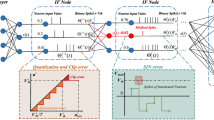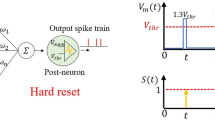Abstract
Spiking neural networks (SNNs) have attracted great attention due to their distinctive properties of low power consumption and high computing efficiency on neuromorphic hardware. An effective way to obtain deep SNNs with competitive accuracy on large-scale datasets is ANN-SNN conversion. However, it requires a long time window to get an optimal mapping between the firing rates of SNNs and the activation of ANNs due to conversion error. Compared with the source ANN, the converted SNN usually suffers a huge loss of accuracy at ultra-low latency. In this paper, we first analyze the residual membrane potential error caused by the asynchronous transmission property of spikes at ultra-low latency, and we deduce an explicit expression for the residual membrane potential error (RMPE) and the SNN parameters. Then we propose a layer-by-layer calibration algorithm for these SNN parameters to eliminate RMPE. Finally, a two-stage ANN-SNN conversion scheme is proposed to eliminate the quantization error, the truncation error, and the RMPE separately. We evaluate our method on CIRFARs and ImageNet, and the experimental results show that the proposed ANN-SNN conversion method has a significant reduction in accuracy loss at ultra-low-latency. When T is \(\le 64\), our method requires about half the latency of other methods of similar accuracy on ImageNet. The code is available at https://github.com/JominWink/SNN_Conversion_Phase.
Access this chapter
Tax calculation will be finalised at checkout
Purchases are for personal use only
Similar content being viewed by others
References
Bu, T., Fang, W., Ding, J., Dai, P., Yu, Z., Huang, T.: Optimal ANN-SNN conversion for high-accuracy and ultra-low-latency spiking neural networks. In: International Conference on Learning Representations (2022)
Pfeiffer, M., Pfeil, T.: Deep learning with spiking neurons: opportunities and challenges. Front. Neurosci. 12, 774 (2018)
Xiao, J., Guo, H., Zhou, J., Zhao, T., Yu, Q., Chen, Y.: Tiny object detection with context enhancement and feature purification. Expert Syst. Appl. 211, 118665–118674 (2023)
Xiao, J., Wu, Y., Chen, Y., Wang, S., Wang, Z., Ma, J.: LSTFE-net: Long short-term feature enhancement network for video small object detection. In: Proceedings of the IEEE/CVF Conference on Computer Vision and Pattern Recognition, pp. 14613–14622 (2023)
Lee, J.H., Delbruck, T., Pfeiffer, M.: Training deep spiking neural networks using backpropagation. Front. Neurosci. 10, 508 (2016)
Tavanaei, A., Maida, A.: BP-STDP: approximating backpropagation using spike timing dependent plasticity. Neurocomputing 330, 39–47 (2019)
Cao, Y., Chen, Y., Khosla, D.: Spiking deep convolutional neural networks for energy-efficient object recognition. Int. J. Comput. Vision 113(1), 54–66 (2015)
Chen, Y., Mai, Y., Feng, R., Xiao, J.: An adaptive threshold mechanism for accurate and efficient deep spiking convolutional neural networks. Neurocomputing 469, 189–197 (2022)
Diehl, P.U., Neil, D., Binas, J., Cook, M., Liu, S.C., Pfeiffer, M.: Fast-classifying, high-accuracy spiking deep networks through weight and threshold balancing. In: International Joint Conference on Neural Networks, pp. 1–8 (2015)
Bu, T., Ding, J., yu, Z., Huang, T.: Optimized potential initialization for low-latency spiking neural networks. In: Proceedings of the AAAI Conference on Artificial Intelligence, vol. 36, pp. 11–20, June 2022
Li, Y., Deng, S., Dong, X., Gong, R., Gu, S.: A free lunch from ANN: towards efficient, accurate spiking neural networks calibration. In: International Conference on Machine Learning, pp. 6316–6325 (2021)
Mueller, E., Hansjakob, J., Auge, D., Knoll, A.: Minimizing inference time: Optimization methods for converted deep spiking neural networks. In: International Joint Conference on Neural Networks, pp. 1–8 (2021)
Deng, S., Gu, S.: Optimal conversion of conventional artificial neural networks to spiking neural networks. ArXiv abs/2103.00476 (2021)
Datta, G., Beerel, P.A.: Can deep neural networks be converted to ultra low-latency spiking neural networks? In: Automation & Test in Europe Conference & Exhibition, pp. 718–723 (2022)
Rueckauer, B., Liu, S.C.: Conversion of analog to spiking neural networks using sparse temporal coding. In: 2018 IEEE International Symposium on Circuits and Systems, pp. 1–5 (2018)
Rueckauer, B., Lungu, I.A., Hu, Y., Pfeiffer, M., Liu, S.C.: Conversion of continuous-valued deep networks to efficient event-driven networks for image classification. Front. Neurosci. 11, 682 (2017)
Han, B., Srinivasan, G., Roy, K.: RMP-SNN: residual membrane potential neuron for enabling deeper high-accuracy and low-latency spiking neural network. In: IEEE Conference on Computer Vision and Pattern Recognition, pp. 13558–13567 (2020)
Liu, F., Zhao, W., Chen, Y., Wang, Z., Jiang, L.: Spikeconverter: an efficient conversion framework zipping the gap between artificial neural networks and spiking neural networks, vol. 36, pp. 1692–1701 (2022)
Meng, Q., Yan, S., Xiao, M., Wang, Y., Lin, Z., Luo, Z.Q.: Training much deeper spiking neural networks with a small number of time-steps. Neural Netw. 153, 254–268 (2022)
Rathi, N., Roy, K.: DIET-SNN: a low-latency spiking neural network with direct input encoding and leakage and threshold optimization. IEEE Trans. Neural Netw. Learn. Syst. 34(6), 3174–3182 (2023). https://doi.org/10.1109/TNNLS.2021.3111897
Horowitz, M.: 1.1 computing’s energy problem (and what we can do about it). In: IEEE International Solid-State Circuits Conference Digest of Technical Papers, pp. 10–14 (2014)
Li, Y., Deng, S.W., Dong, X., Gu, S.: Converting artificial neural networks to spiking neural networks via parameter calibration. ArXiv abs/2205.10121 (2022)
Acknowledgment
This work was supported by the National Key Research and Development Program of China (No.2021YFB2501104) and the Natural Science Foundation of Guangdong Province, China (No. 2021A1515012233).
Author information
Authors and Affiliations
Corresponding author
Editor information
Editors and Affiliations
Rights and permissions
Copyright information
© 2024 The Author(s), under exclusive license to Springer Nature Singapore Pte Ltd.
About this paper
Cite this paper
Chen, Y., Xiong, Z., Feng, R., Chen, P., Xiao, J. (2024). RMPE:Reducing Residual Membrane Potential Error for Enabling High-Accuracy and Ultra-low-latency Spiking Neural Networks. In: Luo, B., Cheng, L., Wu, ZG., Li, H., Li, C. (eds) Neural Information Processing. ICONIP 2023. Lecture Notes in Computer Science, vol 14449. Springer, Singapore. https://doi.org/10.1007/978-981-99-8067-3_7
Download citation
DOI: https://doi.org/10.1007/978-981-99-8067-3_7
Published:
Publisher Name: Springer, Singapore
Print ISBN: 978-981-99-8066-6
Online ISBN: 978-981-99-8067-3
eBook Packages: Computer ScienceComputer Science (R0)




